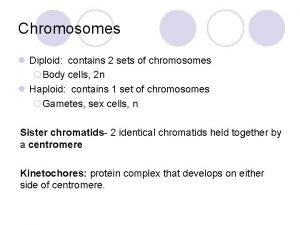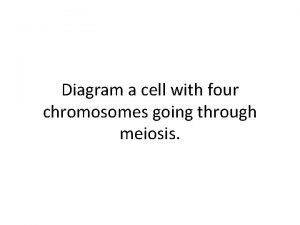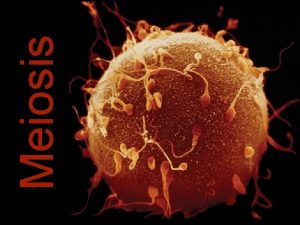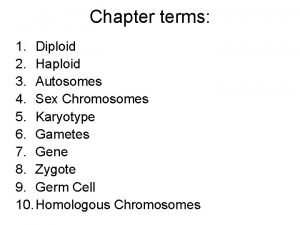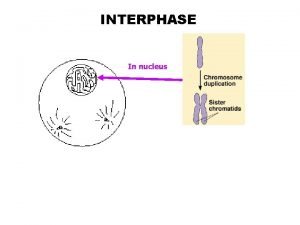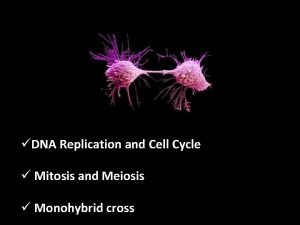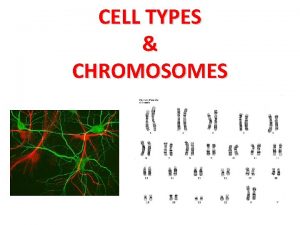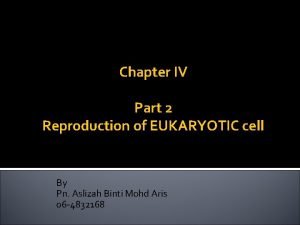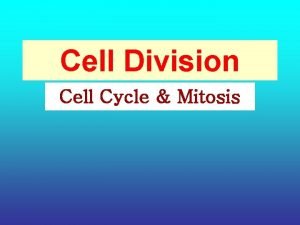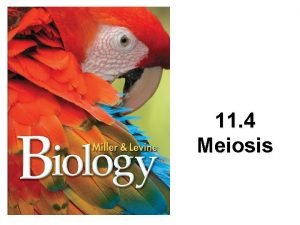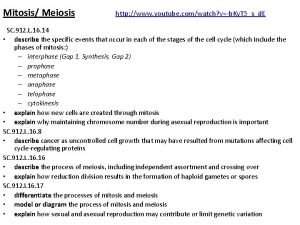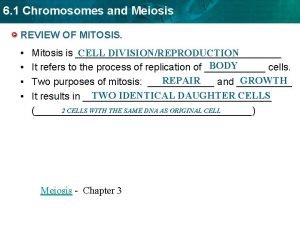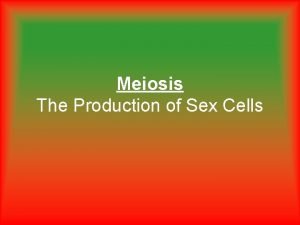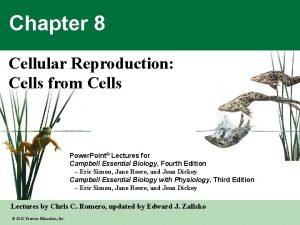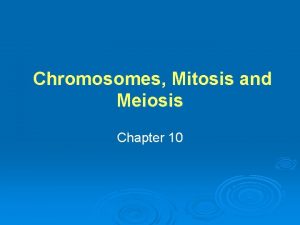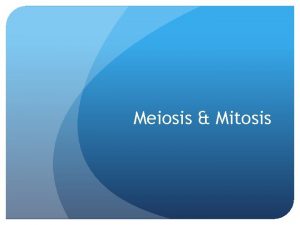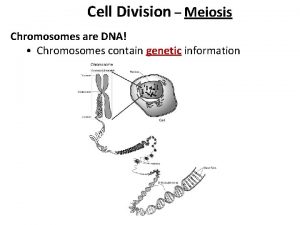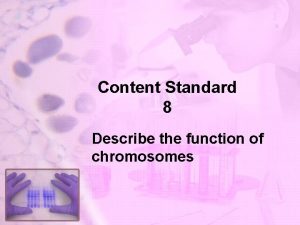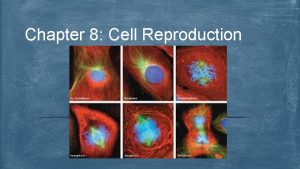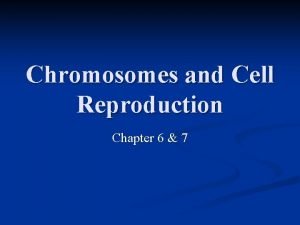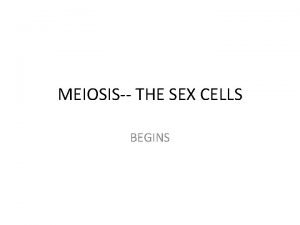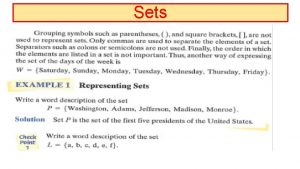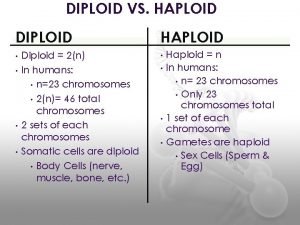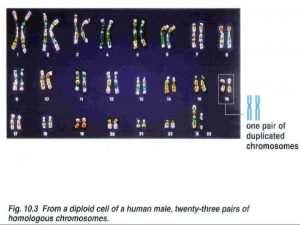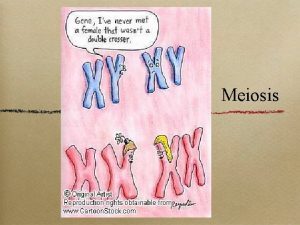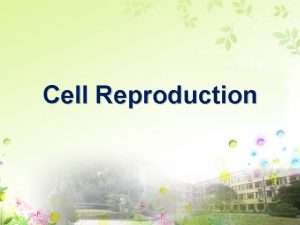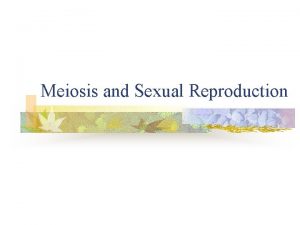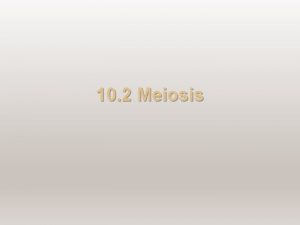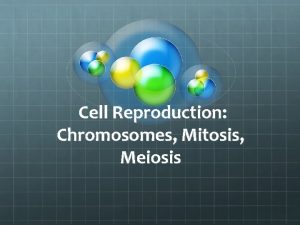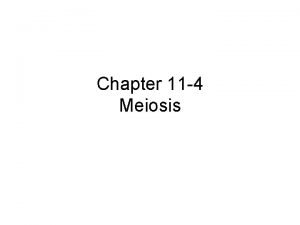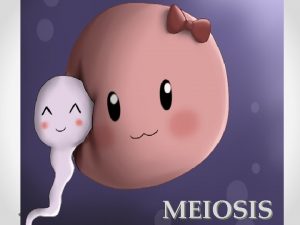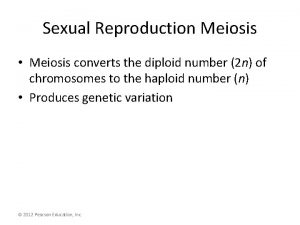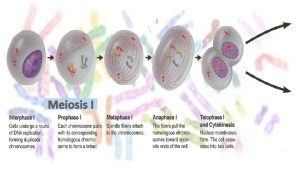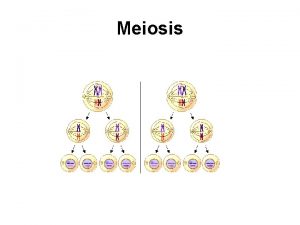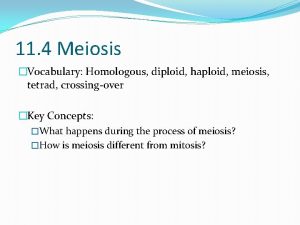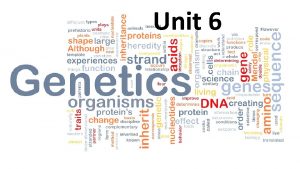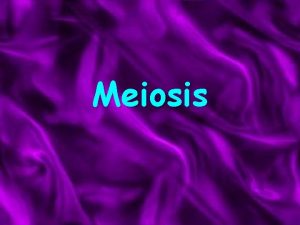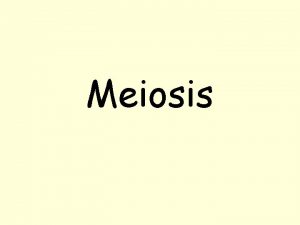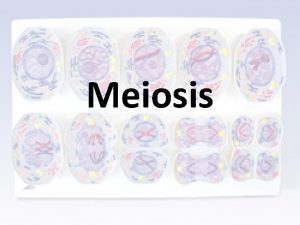Meiosis The Diploid Cell with sets of chromosomes

































- Slides: 33

Meiosis

The Diploid Cell with ___ sets of chromosomes Contains chromosomes for each _____ pair _____ = Body Cells: Diploid All human cells except ______ are diploid Where does the diploid number come from? ____, where n is the number of chromosomes an individual has What is n for humans? ______ 2 n? ______

The Haploid Cell containing ___ of each kind of chromosome Examples: __________ ___ set of chromosomes _____ the number of chromosomes of diploid ___ Sperm + Egg = Zygote

Haploid = one of each kind Diploid = two of each kind + or 2 n = diploid n = haploid

Mitosis vs. Meiosis • Mitosis: t = two: Diploid 2 n=46 • Meiosis: o = one: Haploid n = 23

Meiosis _____ are produced in specialized body cells Sperm and Egg Cells __ divisions: ____________ Meiosis occurs in ____ cells, not _____ cells __ daughter cells Each cell has ____ the chromosomes of the parent

Meiosis I Interphase occurs: the cell grows and DNA replicates Meiosis I begins Original cell produces two new cells Like Mitosis

Prophase I DNA Coils tightly into chromosomes Spindle fibers appear Each chromosome lines up next to the homologue Synapis occurs: pairing of homologous chromosomes Tetrad: Each pair of homologous chromosomes

Crossing Over: why we do not look exactly like our parents. • Portions of the ______ breaks off and attaches to ________ on the _______ chromosome Permits _____________ between maternal and paternal chromosomes • Occurs during _______


Genetic Recombination Crossing over produces a new mixture of genetic material

Causes of Variation Chromosomes are assorted randomly Crossing over may occur Cells do not have identical genetic info as each other or the parent + ______________ - _______________

Metaphase I Tetrads line up randomly along the mid-line Spindle fibers attach to centromeres

Anaphase I Homologous chromosomes move to the opposite poles Random separation or Independent Assortment results in separation of maternal and paternal chromosomes.

Telophase I Chromosomes reach opposite ends of cell Cytokinesis begins Cell is now haploid

Meiosis II Occurs in each cell formed in Meiosis I Interphase does not occur again

Prophase II Spindle fibers form and move the chromosomes to the mid-line of the dividing cell

Metaphase II Chromosomes move to the midline of the dividing cell facing opposite poles of the dividing cell

Anaphase II Chromatids separate and move to opposite poles of the cell

Telophase II Nuclear membrane forms around the chromosomes in each of 4 new cells

Cytokinesis II _____ divides __________ closes off

End Result: ____ new cells that contain _____ of the original cells number of chromosomes Creates _____ = _____

What exactly is a gamete? Formed by ______________ cells In humans, meiosis occurs in the testes and ovaries

Meiosis Animation • Meiosis Animation

Why do we need haploid gametes? Female gamete Male gamete 23 23 EGG SPERM

Fertilization restores the diploid number 1 n fertilization 1 n meiosis 2 n 2 n Mitosis and cell growth 2 n


Mitosis vs. Meiosis • Mitosis vs. Meiosis Animation Notes:

Nondisjunction • • Failure of __________ to ______ properly during meiosis. _________ of a homologous pair move to the ______ of the cell. • 1 gamete has __________ Or • 1 gamete is ___________

Nondisjunction Animation • Nondisjunction Animation Notes:

Chromosome Pop Quiz! • What is a chromosome? • Where do we find them? • What do they look like? • • How many pairs of chromosomes do humans have? What determines if someone is male or female?

Trisomy: Extra Chromosomes • Trisomy 13: Patau’s Syndrome • Trisomy 21: Down’s Syndrome • XXX: Trisomy X • XYY: Jacob’s Syndrome • XXY: Klinefelter’s Syndrome

Monosomy: Missing Chromosomes • • • Most do not survive. Turner XO : develop as girls, but infertile OY: lethal
 Diploid contains 2 sets of chromosomes
Diploid contains 2 sets of chromosomes Four chromosomes going through mitosis
Four chromosomes going through mitosis Diagrams of mitosis
Diagrams of mitosis Meiosis and mitosis
Meiosis and mitosis Are diploid cells produced in meiosis
Are diploid cells produced in meiosis Bit.ly/2m8prtt
Bit.ly/2m8prtt Diploid cell
Diploid cell Diploid cell
Diploid cell Iaaba
Iaaba Diploid cell
Diploid cell Chromosome sets (=n) in mitosis and meiosis
Chromosome sets (=n) in mitosis and meiosis Anaphase meaning
Anaphase meaning Number of chromosomes in meiosis
Number of chromosomes in meiosis Mitosis and meiosis
Mitosis and meiosis Chromosomes number is maintained mitosis or meiosis
Chromosomes number is maintained mitosis or meiosis Meiosis and mitosis
Meiosis and mitosis How many chromosomes do humans have
How many chromosomes do humans have Non disjunction in meiosis 1 and 2
Non disjunction in meiosis 1 and 2 Synapsis of homologous chromosomes in meiosis
Synapsis of homologous chromosomes in meiosis Meiosis
Meiosis Where does cell mitosis occur in skin
Where does cell mitosis occur in skin Study guide chapter 10 section 1 meiosis
Study guide chapter 10 section 1 meiosis Anaphase in meiosis vs mitosis
Anaphase in meiosis vs mitosis Chapter 10 meiosis 1 and meiosis 2
Chapter 10 meiosis 1 and meiosis 2 Meiosis genetic variation
Meiosis genetic variation Metaphase 1
Metaphase 1 Differences between mitosis and meiosis
Differences between mitosis and meiosis Chromosomes main function
Chromosomes main function Cell with 4 chromosomes
Cell with 4 chromosomes Chapter 6 chromosomes and cell reproduction
Chapter 6 chromosomes and cell reproduction Cell division mitosis and meiosis
Cell division mitosis and meiosis Meiosis
Meiosis Comparing mitosis and meiosis
Comparing mitosis and meiosis Egg cell meiosis
Egg cell meiosis
